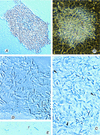In vitro cultivation of microsporidia of clinical importance
- PMID: 12097248
- PMCID: PMC118077
- DOI: 10.1128/CMR.15.3.401-413.2002
In vitro cultivation of microsporidia of clinical importance
Abstract
Although attempts to develop methods for the in vitro cultivation of microsporidia began as early as 1937, the interest in the culture of these organisms was confined mostly to microsporidia that infect insects. The successful cultivation in 1969 of Encephalitozoon cuniculi, a microsporidium of mammalian origin, and the subsequent identification of these organisms as agents of human disease heightened interest in the cultivation of microsporidia. I describe the methodology as well as the cell lines, the culture media, and culture conditions used in the in vitro culture of microsporidia such as Brachiola (Nosema) algerae, Encephalitozoon cuniculi, E. hellem, E. intestinalis, Enterocytozoon bieneusi, Trachipleistophora hominis, and Vittaforma corneae that cause human disease.
Figures










Similar articles
-
First detection and genotyping of human-associated microsporidia in pigeons from urban parks.Appl Environ Microbiol. 2005 Jun;71(6):3153-7. doi: 10.1128/AEM.71.6.3153-3157.2005. Appl Environ Microbiol. 2005. PMID: 15933015 Free PMC article.
-
First identification and genotyping of Enterocytozoon bieneusi and Encephalitozoon spp. in pet rabbits in China.BMC Vet Res. 2020 Jun 22;16(1):212. doi: 10.1186/s12917-020-02434-z. BMC Vet Res. 2020. PMID: 32571322 Free PMC article.
-
The first report on natural Enterocytozoon bieneusi and Encephalitozoon spp. infections in wild East-European House Mice (Mus musculus musculus) and West-European House Mice (M. m. domesticus) in a hybrid zone across the Czech Republic-Germany border.Vet Parasitol. 2011 Jun 10;178(3-4):246-50. doi: 10.1016/j.vetpar.2010.12.044. Epub 2011 Jan 12. Vet Parasitol. 2011. PMID: 21269775
-
Microsporidia: emerging pathogenic protists.Acta Trop. 2001 Feb 23;78(2):89-102. doi: 10.1016/s0001-706x(00)00178-9. Acta Trop. 2001. PMID: 11230819 Review.
-
[Microsporidia: general characteristics, infections and laboratory diagnosis].Mikrobiyol Bul. 2005 Oct;39(4):513-22. Mikrobiyol Bul. 2005. PMID: 16544554 Review. Turkish.
Cited by
-
Therapeutic targets for the treatment of microsporidiosis in humans.Expert Opin Ther Targets. 2018 Nov;22(11):903-915. doi: 10.1080/14728222.2018.1538360. Epub 2018 Nov 1. Expert Opin Ther Targets. 2018. PMID: 30336698 Free PMC article. Review.
-
Three Cases of Neurologic Syndrome Caused by Donor-Derived Microsporidiosis.Emerg Infect Dis. 2017 Mar;23(3):387-395. doi: 10.3201/eid2303.161580. Emerg Infect Dis. 2017. PMID: 28220747 Free PMC article.
-
Phylogenetic approach to the variability of the microsporidian Enterocytozoon bieneusi and its implications for inter- and intrahost transmission.Appl Environ Microbiol. 2010 May;76(10):3333-42. doi: 10.1128/AEM.03026-09. Epub 2010 Mar 12. Appl Environ Microbiol. 2010. PMID: 20228101 Free PMC article.
-
Practical Guidance for Clinical Microbiology Laboratories: Laboratory Diagnosis of Parasites from the Gastrointestinal Tract.Clin Microbiol Rev. 2017 Nov 15;31(1):e00025-17. doi: 10.1128/CMR.00025-17. Print 2018 Jan. Clin Microbiol Rev. 2017. PMID: 29142079 Free PMC article. Review.
-
Encephalitozoon: Tissue Culture, Cryopreservation, and Murine Infection.Curr Protoc Microbiol. 2019 Feb;52(1):e72. doi: 10.1002/cpmc.72. Epub 2018 Nov 16. Curr Protoc Microbiol. 2019. PMID: 30444582 Free PMC article.
References
-
- Bocket, L., C. H. Marquette, A. Dewilde, D. Hober, and P. Wattre. 1992. Isolation and replication in human fibroblast cell (MRC-5) of a microsporidian from an AIDS patient. Microb. Pathog. 12:187-191. - PubMed
-
- Canning, E. U., and J. Lom. 1986. The microsporidia of vertebrates. Academic Press, Inc., New York, N.Y.
-
- Croppo, G. P., G. S. Visvesvara, G. J. Leitch, S. Wallace, and M. A. De Groote. 1997. Western blot and immunofluorescence analysis of a human isolate of Encephalitozoon cuniculi established in culture from the urine of a patient with AIDS. J. Parasitol. 83:66-69. - PubMed
-
- Croppo, G. P., G. S. Visvesvara, G. J. Leitch, S. Wallace, and D. A. Schwartz. 1998. Western blot identification of the microsporidian Encephalitozoon hellem using immunoglobulin G monoclonal antibodies. Arch. Pathol. Lab. Med. 122:182-186. - PubMed
-
- De Groote, M. A., G. S. Visvesvara, M. L. Wilson, N. J. Pieniazek, S. B. Slemenda, A. J. da Silva, G. J. Leitch, R. T. Bryan, and R. Reves. 1995. Polymerase chain reaction and culture confirmation of disseminated Encephalitozoon cuniculi in a patient with AIDS: successful therapy with albendazole. J. Infect. Dis. 171:1375-1378. - PubMed
Publication types
MeSH terms
LinkOut - more resources
Full Text Sources

